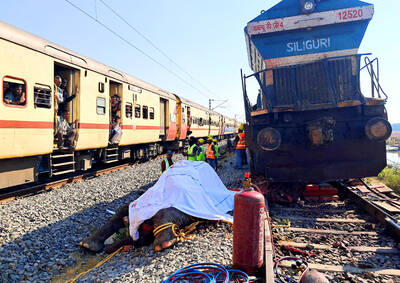The head of a team of engineering experts told a US Senate committee on Wednesday that malfeasance during construction might have been one reason for the catastrophic failure of the levees that were supposed to protect New Orleans from hurricanes.
"These levees should have been expected to perform adequately at these levels if they had been designed and constructed properly," said Raymond Seed, a professor of civil engineering at the University of California, Berkeley.
"Not just human error was involved," Seed said. "There may have been malfeasance."
Seed, whose team was funded by the National Science Foundation, did not offer hard evidence to back up his accusation. But he said after the hearing that the team had been contacted by levee workers, contractors and, in some cases, widows of contractors who told stories of protective sheet pile being driven less deeply than plans called for and corners cut in choosing soils for construction, among other problems.
His group is trying to confirm the accounts, he said, and he cautioned that even if proved, they might not be a major contributing factor in the disaster, which killed 1,000 people and left 100,000 without homes.
As experts have noted, the levee specifications may not have been adequate in the first place. In particular, pilings may not have been driven deep enough to keep them from collapsing.
But the testimony raises new concerns in the aftermath of Hurricane Katrina about the protection that New Orleans received from the 40-year US$458 million flood-control system.
The current state of repair might not protect the city from another serious storm, the engineers warned.
"Short term, without a storm, they are probably adequately safe," said Peter Nicholson, a professor of civil engineering at the University of Hawaii, who led a team of levee investigators for the American Society of Civil Engineers. "Certainly with a large storm, as we are not yet out of hurricane season, and certainly for next hurricane season, there is significant risk," Nicholson said.

The Burmese junta has said that detained former leader Aung San Suu Kyi is “in good health,” a day after her son said he has received little information about the 80-year-old’s condition and fears she could die without him knowing. In an interview in Tokyo earlier this week, Kim Aris said he had not heard from his mother in years and believes she is being held incommunicado in the capital, Naypyidaw. Aung San Suu Kyi, a Nobel Peace Prize laureate, was detained after a 2021 military coup that ousted her elected civilian government and sparked a civil war. She is serving a

REVENGE: Trump said he had the support of the Syrian government for the strikes, which took place in response to an Islamic State attack on US soldiers last week The US launched large-scale airstrikes on more than 70 targets across Syria, the Pentagon said on Friday, fulfilling US President Donald Trump’s vow to strike back after the killing of two US soldiers. “This is not the beginning of a war — it is a declaration of vengeance,” US Secretary of Defense Pete Hegseth wrote on social media. “Today, we hunted and we killed our enemies. Lots of them. And we will continue.” The US Central Command said that fighter jets, attack helicopters and artillery targeted ISIS infrastructure and weapon sites. “All terrorists who are evil enough to attack Americans are hereby warned

Seven wild Asiatic elephants were killed and a calf was injured when a high-speed passenger train collided with a herd crossing the tracks in India’s northeastern state of Assam early yesterday, local authorities said. The train driver spotted the herd of about 100 elephants and used the emergency brakes, but the train still hit some of the animals, Indian Railways spokesman Kapinjal Kishore Sharma told reporters. Five train coaches and the engine derailed following the impact, but there were no human casualties, Sharma said. Veterinarians carried out autopsies on the dead elephants, which were to be buried later in the day. The accident site

RUSHED: The US pushed for the October deal to be ready for a ceremony with Trump, but sometimes it takes time to create an agreement that can hold, a Thai official said Defense officials from Thailand and Cambodia are to meet tomorrow to discuss the possibility of resuming a ceasefire between the two countries, Thailand’s top diplomat said yesterday, as border fighting entered a third week. A ceasefire agreement in October was rushed to ensure it could be witnessed by US President Donald Trump and lacked sufficient details to ensure the deal to end the armed conflict would hold, Thai Minister of Foreign Affairs Sihasak Phuangketkeow said after an ASEAN foreign ministers’ meeting in Kuala Lumpur. The two countries agreed to hold talks using their General Border Committee, an established bilateral mechanism, with Thailand